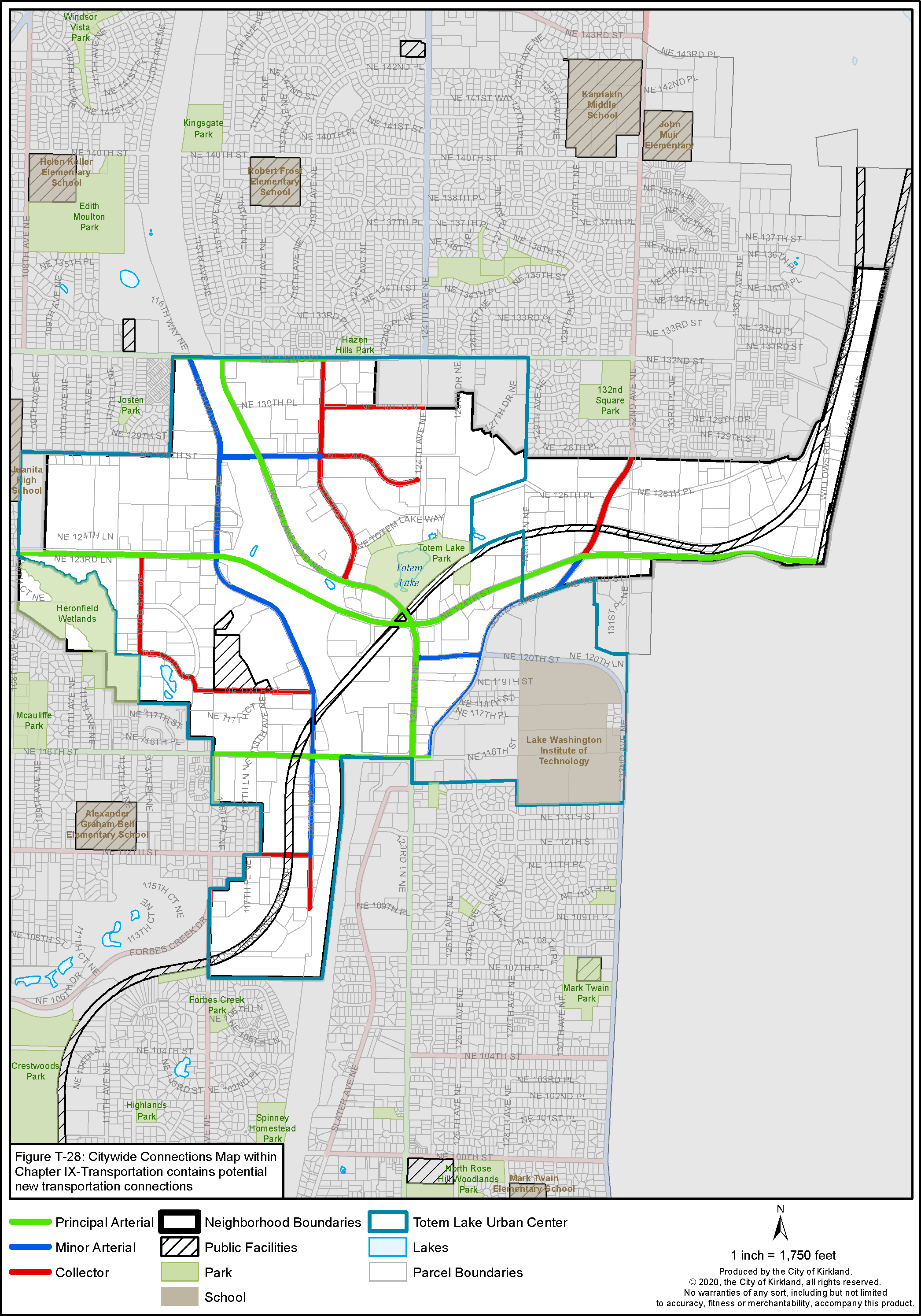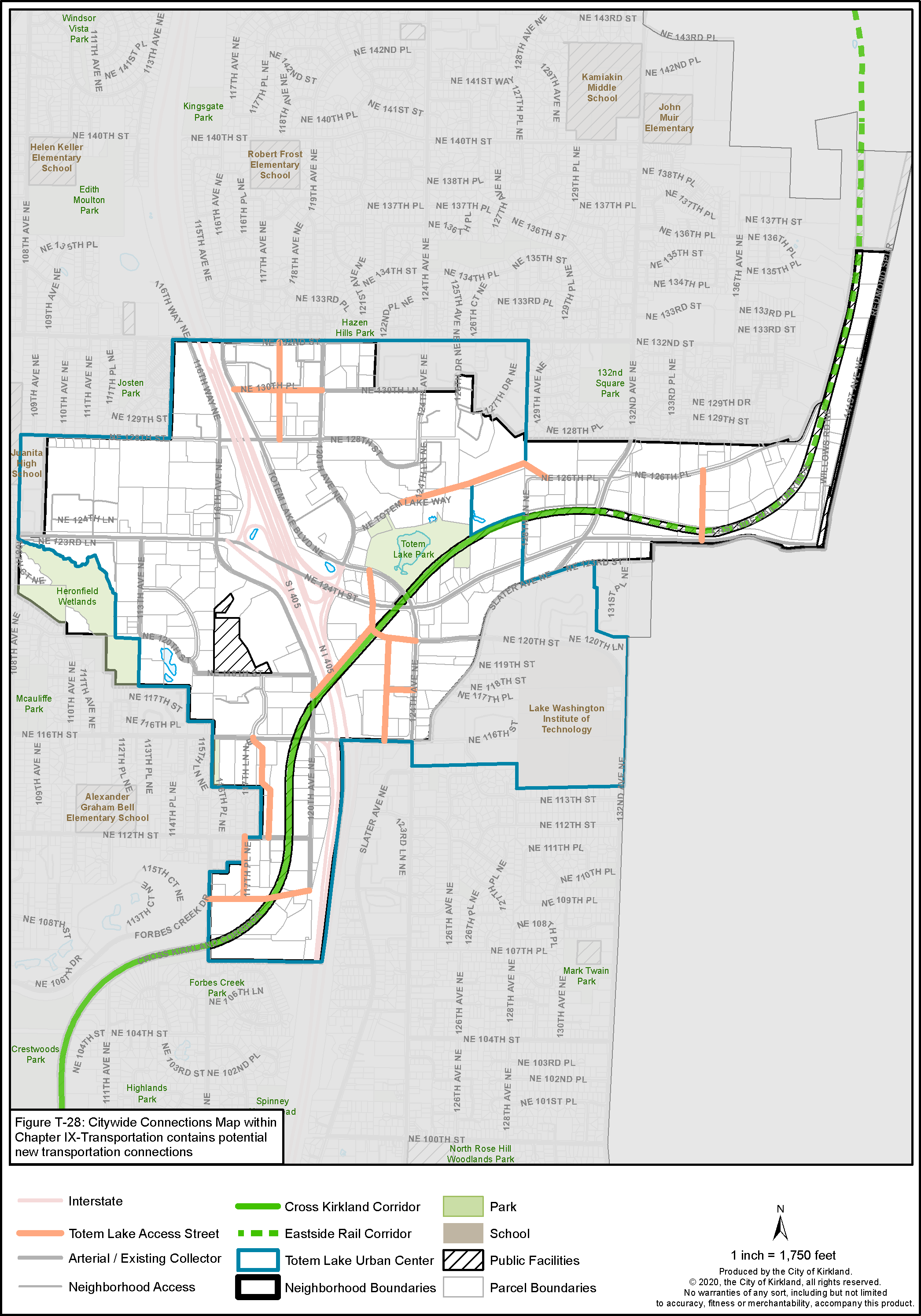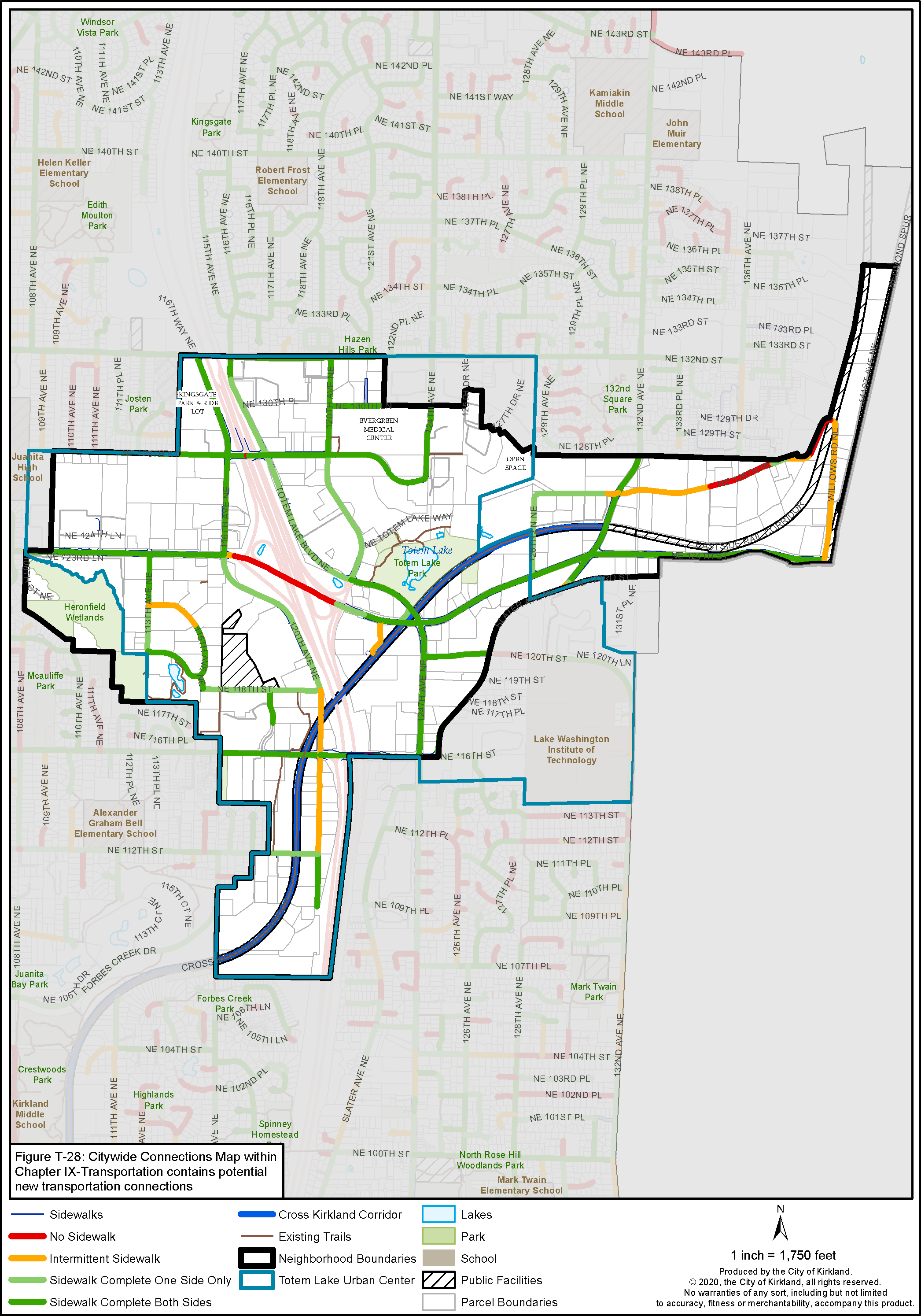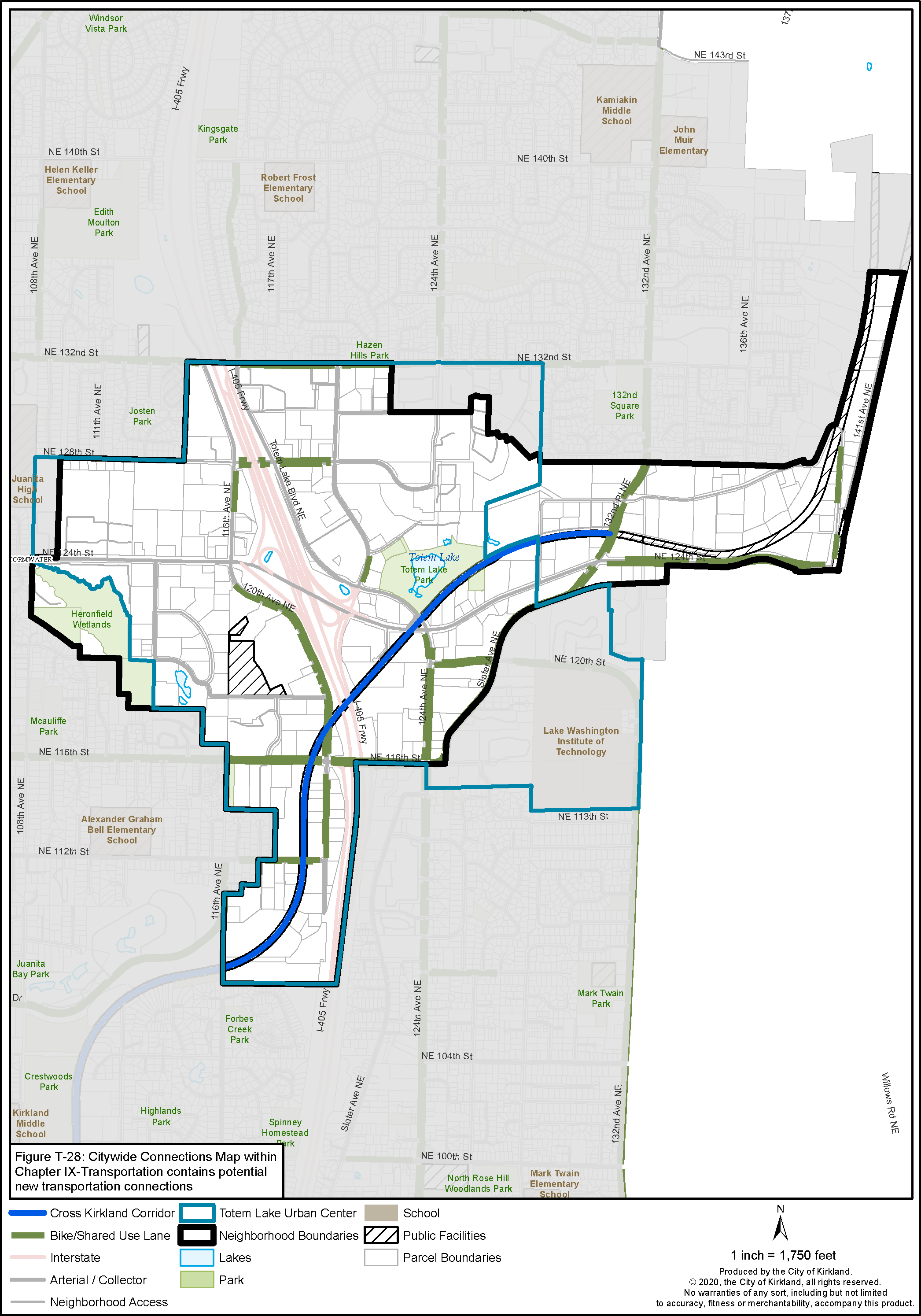8. Transportation
The Transportation Element of this Comprehensive Plan provides a transportation concept for the City of Kirkland that supports a system which promotes all viable forms of transportation, ensures consistency between land use and transportation planning, ensures sustainability in the system, and emphasizes the development and maintenance of partnerships locally, regionally and nationally to further transportation goals. The Transportation Element provides specific goals and policies that support the development of a multimodal transportation system in Totem Lake.
The concentration of economic activity in the Totem Lake Business District and Urban Center requires an efficient transportation system. As the Urban Center transitions from a largely auto-oriented district to one that relies on a range of modes to support increased density, this transportation system should emphasize multiple modes of transportation, with improved access to transit hubs by walking and bicycling access. The City should take advantage of the funding priority given to regionally designated Urban Centers to seek grants for funding transportation improvements.
Goal TL-12: Strive to achieve, by 2035, a non-single occupancy vehicle mode share of 60 percent for peak period trips in the Totem Lake Urban Center.
An ambitious mode split may be achieved within the Urban Center through a number of measures supported by this Plan. These include the creation of transit- and pedestrian-supportive land uses and infrastructure, the provision of expanded transit options and enhanced transportation demand strategies, incentives for travel by HOV, and the implementation of a parking management strategy. The table below provides goals for the mode split to be achieved.
|
Totem Lake Mode Split |
||||||
|---|---|---|---|---|---|---|
|
Daily Home-Based Work Trips |
Peak Hour – All Trip Types |
|||||
|
Mode |
2010 PSRC |
2035 Estimate |
2035 Aspirational Target |
2012 BKR |
2035 Estimate |
2035 Aspirational Target |
|
SOV |
81% |
74% |
64% |
55% |
45% |
40% |
|
HOV |
9% |
13% |
15% |
38% |
39% |
40% |
|
Transit |
7% |
9% |
15% |
4% |
7% |
10% |
|
Walk & Bike |
3% |
4% |
6% |
3% |
9% |
10% |
|
100% |
100% |
100% |
100% |
100% |
100% |
|
Goal TL-13: Provide mobility within the business district through maximizing the efficiency and safety of the existing road network and making strategic investments in intersections and street capacity to support planned land use.
The district has an established network of streets that serve vehicular needs. I-405 provides regional access to the business district. Principal arterials (NE 124th Street, 124th Avenue NE) connect Totem Lake with other regional locations such as Bellevue and Redmond. Minor arterials (NE 116th Street, Totem Lake Boulevard, 132nd Avenue NE, NE 132nd Street, NE 120th Street) provide connections between principal arterials and serve as key circulation routes within the district. Collector streets distribute traffic from the arterials to local streets, giving access to individual properties (see Figure TL-5).
Policy TL-13.1: Maximize efficiency of the existing transportation network.
Many low-cost traffic management strategies can be employed to maximize the efficiency and improve the safety of the existing transportation network. Intelligent Transportation Systems (ITS), for example, maximize the efficiency of the existing transportation system and can improve mobility through techniques such as transit priority signalization. Other measures to increase the efficiency of existing streets include intersection improvements, on-street parking restrictions, signal timing optimization and left turn channelization. Substantial reductions in congestion from modest intersection improvements that support planned land use may be achieved in some areas, such as NE 132nd Street. Priorities for street improvements are established in the Transportation Element.
Goal TL-14: Support transportation demand management (TDM) measures and improve transit facilities and services.
Policy TL-14.1: Support transportation demand management (TDM) efforts to reduce trip demand and meet goals for non-drive-alone trips in the Urban Center.
TDM seeks to modify travel behavior and encourage economical alternatives to the single-occupant vehicle. The City has ongoing TDM and Commute Trip Reduction (CTR) programs that work with employers to reduce single-occupancy vehicle use and vehicle miles traveled. As discussed in the Transportation Element, innovative approaches should be implemented to improve ridesharing, vanpools and other types of services.
Figure TL-5: Totem Lake Street Classifications
Many components of a successful TDM program could include costs to the City. Financial subsidies to encourage employers to provide vanpools for their employees, or other incentives to reduce the costs of participation for employees are examples of costs the City might incur. The City should seek grant funding for program costs and partnering with transit and other agencies should be promoted.
Policy TL-14.2: Strive to meet the goals established for the Totem Lake Urban Center Growth and Transportation Efficiency Center (GTEC).
The GTEC designation is a voluntary Commute Trip Reduction (CTR) strategy that encourages reduction of Single Occupancy Vehicles (SOV), and Vehicle Miles Traveled (VMT) and reductions in greenhouse gas emissions through efficient use of transportation infrastructure and travel demand management strategies discussed above. The purpose of the GTEC is to increase access to the Urban Center while reducing the number of drive alone trips.
The Transportation Master Plan and the City’s CTR Plan provide further details on CTR and TDM plans. The goals established for Totem Lake GTEC include a non-SOV rate of 55 percent, and reductions in greenhouse gas emissions and vehicle miles traveled of 28 percent each.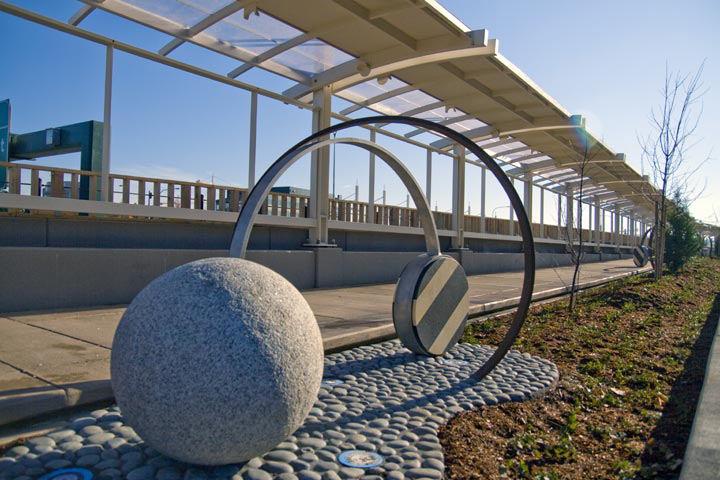
Goal TL-15: Support and promote an improved transit system and access to transit hubs within the Urban Center.
Policy TL-15.1: Work with regional transit agencies to provide a full range of transit service to and within the Totem Lake Urban Center.
Transit service to the Totem Lake Urban Center has improved in recent years, with the completion of the direct access HOV lanes at I-405/NE 128th Street and transit center on the Evergreen Health campus. These projects have improved the speed, reliability and use of regional express transit service in Kirkland, and have been an integral part of the plan and vision for the Totem Lake Urban Center. Additional improvements to Metro and Sound Transit service to and from the Urban Center should continue to be encouraged.
Due to the size of the Totem Lake Urban Center, it is important that regional transit effectively serves the entire area. Throughout the Totem Lake Business District, expanded transit service to connect to other Eastside communities, to provide more frequent service during peak hours, and to expand service from the Kingsgate Park-and-Ride lots should be provided. Additional transit shelters and stops should be encouraged, with improved access to transit hubs by walking and bicycling access. Intensive promotion should be sought for implementation of local transit services to Totem Lake residents and businesses.
In order to promote improved regional service for Totem Lake’s residents and employees, the City should support efforts to incorporate High Capacity Transit (HCT) on I-405 and consider appropriate transit on the Cross Kirkland Corridor.
Goal TL-16: Improve local circulation in the Totem Lake Business District.
The Totem Lake Business District has barriers to local circulation including I-405, the Cross Kirkland Corridor, large “superblocks” without internal connections, steep slopes and wetlands. Because of these features, the pattern of local streets can feel circuitous, confusing and inconvenient. The improvements described below would simplify and improve local circulation.
Policy TL-16.1: Create a landscaped boulevard that connects the subareas within the business district.
Although primarily for urban design purposes, the landscaped boulevard would not only connect visually the subareas of the business district around the I-405 interchange at NE 124th Street, but could also help local circulation. Creation of the boulevard uses existing rights-of-way such as Totem Lake Boulevard, 120th Avenue NE, NE 128th Street and 116th Avenue NE to the greatest extent possible. In some areas dedication and development of new rights-of-way may be needed. Please refer to the Urban Design policies and Figure TL-10 for the preferred alignment of the boulevard.
Policy TL-16.2: Seek opportunities to create a finer grid of smaller scale streets and new connections within the business district.
The Totem Lake Business District currently has a limited local street system. Development of a complete network of local access roads would facilitate vehicular, pedestrian and bicycle access to properties, reduce reliance on major arterial routes, and break up large blocks to provide better building orientation to the street and an improved street level environment.
With new development and redevelopment within the business district, the opportunity exists for the dedication of right-of-way to enable the creation of new through connections. General locations for potential new connections are identified in Figure T-28 in Chapter IX, Transportation.
Goal TL-17: Improve circulation and access for nonmotorized modes of transportation.
To provide transportation alternatives to the automobile, safe and convenient paths should be developed for pedestrians, bicycles, scooters, skates and other nonmotorized modes of travel. The Transportation Element and Transportation Master Plan provide specific policy direction and actions to support and enhance these modes.
Policy TL-17.1: Develop a safe, integrated on- and off-street nonmotorized system emphasizing connections to schools, parks, transit, the Cross Kirkland Corridor and other parts of Kirkland (Figures TL-7 and TL-8).
The Totem Lake Business District needs many nonmotorized improvements, as identified in the City’s Active Transportation Plan. These include safe and appropriately scaled nonmotorized access to connect neighborhoods, and activity and urban centers, with services, transit, and recreation areas. The relationship of the Totem Lake Business District to other neighborhoods, as well as to the Lake Washington Institute of Technology, Juanita Beach, and the Forbes Creek Trail, should be considered in developing regional connections.
Policy TL-17.2: Support development of the Cross Kirkland Corridor as a multipurpose trail with access points along the corridor.
The Cross Kirkland Corridor provides an important recreational opportunity, as well as a north-south bicycle and pedestrian route through much of the Totem Lake Business District. The trail could also be a precursor of a regional transportation facility traveling through the hearts of many Eastside cities. Public pedestrian and bicycle access should be provided for properties adjacent to the Cross Kirkland Corridor consistent with the CKC Master Plan and the PROS Plan.
Policy TL-17.3: Coordinate with neighboring jurisdictions to obtain and develop the extension of the Cross Kirkland Corridor within Kirkland’s City limits.
The extension of improvements to the CKC north to Woodinville would enable users of the corridor to travel seamlessly across jurisdictional borders.
Figure TL-6: Totem Lake Planned Streets and Possible New Connections
Figure TL-7: Totem Lake Pedestrian System
Figure TL-8: Totem Lake Bicycle System
Goal TL-18: Encourage coordination with regional transportation networks.
The Totem Lake Business District needs to be connected with larger transportation networks on the Eastside and in the region. Totem Lake businesses and residents should have a seamless and effective integration with mobility systems that serve both the business district and external destinations.
Policy TL-18.1: Improve access to the Totem Lake Business District from I-405.
During peak hours, much of the traffic congestion on City arterials such as 124th Avenue NE is partially caused by traffic spillover from I-405. Efforts to reduce the impacts of this spillover include providing additional through capacity on I-405, study of a new interchange at NE 132nd Street with I-405 and I-405 corridor improvements for transit access and expanded transit service. Improvements to the configuration of the interchange at NE 124th Street should also be explored and implemented. The City should support these efforts, and continue to work with the Department of Transportation in the study of the I-405 corridor.



